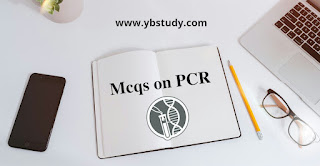MCQ on PCR ( Polymerase Chain Reaction )
MCQ on pcr (polymerase chain reaction) for NEET Pdf :
Hello Students, how are you all hope you all will be good, in this Page we have shared with you more than 20 Important MCQ on pcr ( polymerase chain reaction) which is helpful for NEET Biology. This pcr (polymerases chain reaction ) NEET MCQ will help you to enhance your performance in NEET.
Dear students if you have just started your NEET Biology MCQ Preparation then you must go through our YB NEET Biology MCQ Bank. If you have any dout related to MCQ on pcr ( polymerases chain reaction ) then in this post of today all your douts will be cleared hear…
MCQ on pcr (polymerase chain reaction) for NEET Pdf
1. Primer used for the process of polymerase chain reaction are ___________
a) Single stranded DNA oligonucleotide
b) Double stranded DNA oligonucleotide
c) Single stranded RNA oligonucleotide
d) Double stranded RNA oligonucleotide
Answer: a
2. Polymerase used for PCR is extracted from _____________
a) Escherichia coli
b) Homo sapiens
c) Thermus aquaticus
d) Saccharomyces cerevisiae
Answer: c
3. How many DNA duplex is obtained from one DNA duplex after 4 cycles of PCR?
a) 4
b) 8
c) 16
d) 32
Answer: c
4. At what temperature do denaturation of DNA double helix takes place?
a) 60˚
b) 54˚
c) 74˚
d) 94˚
Answer: d
5. From a single molecule of DNA, PCR can make___________
a) one additional copy
b) hundreds of copies
c) thousands of copies
d) millions of copies
Answer: d
6. A technique for making millions of copies of a specific region of DNA.
a) DNA ligase
b) restriction enzymes
c) gel electrophoresis
d) polymerase chain reaction
Answer: d
7. For gene transfer to be effective, transforming DNA must be____________
a) incorporated into the bacterial chromosome
b) incorporated into a viral genome
c) free in the bacterial cytoplasm
d) none of the above
Answer: a
8. Double stranded DNA denaturation with specified limit of temperature is__________
a) reversible reaction
b) irreversible reaction
c) either (a) or (b)
d) none of these
Answer: a
9. Which of the following is a mismatch?
a) Polymerase – Taq polymerase
b) Template – double stranded DNA
c) Primer – oligonucleotide
d) Synthesis – 5’ to 3’ direction
Answer: b
10. In principle, what outcome would be least expected in a failure to separate pre-PCR and post-PCR activities?
a) False positive reactions
b) False negative reactions
c) Mixed or non-specific PCR products
d) Increased reliability of PCR results
Answer: d
11. What would the expected effect be on a PCR reaction if the primers used were slightly shorter and more variable than the intended oligonucleotide sequences?
a) The PCR reaction would not commence
b) The PCR reaction would end after one cycle
c) The reaction would generate a single short PCR product
d) The reaction would yield a mixture of non-specific products
Answer: a
12. The PCR technique was developed by_________
a) Kohler
b) Altman
c) Milstein
d) Kary Mullis
Answer :d
13. The polymerase chain reaction is_________
a) It is a DNA sequencing technique.
b) It is a DNA degradation technique
c) It is a DNA amplification technique
d) All of the above
Answer :c
14. Which of the following statements is accurate for the PCR – polymerase chain reaction?
a) Automated PCR machines are called thermal cyclers
b) A thermostable DNA polymerase is required
c) Millions to billions of desired DNA copies can be produced from microgram quantities of DNA
d) All of the above
Answer: d
15. Which of the following is an application of polymer chain reaction?
a) Site-directed mutagenesis
b) Site-specific recombination
c) Site-specific translocation
d) All of the above
Answer: a
16. At what temperature does annealing of DNA and primer take place?
a) 54°C
b) 96°C
c) 42°C
d) 74°C
Answer: a
17. Which of the following is the first and the most important step in the polymerase chain reaction?
a) Annealing
b) Primer extension
c) Denaturation
d) None of the above
Answer: c
18.Which of the following statements, if any, is false?
a) The polymerase chain reaction (PCR) is a cell-free method of DNA amplification.
b) PCR is usually used to amplify a specific DNA sequence of interest using oligonucleotide
primers that bind to closely flanking sequences.
c) PCR is superior to cell-based DNA cloning for two major reasons: it is much quicker and
it allows much greater DNA amplification.
d) PCR requires the use of a heat-stable DNA polymerase to make copies of the template DNA.
Answer: c
19. A PCR cycle consists of____________
a) three steps, denaturation, primer annealing and elongation
b) three steps, denaturation, initiation and elongation
c) three steps, primer annealing, elongation and termination
d) three steps, initiation, elongation and termination
Answer: a
20. PCR can be used to amplify a specific fragment of DNA from which of the following?
a) A drop of blood
b) A hair follicle
c) A fragment of skin
d) All of these
Answer : d
21. PCR can be used in_____________
a) cloning
b) sequencing
c) medical diagnosis and forensic medicine
d) all of the above
Answer: d
NEET Related Articles :

